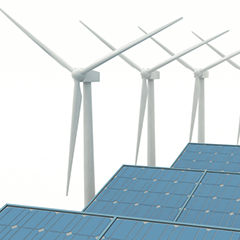A revolutionary concept that will harness the full capacity of grid connections by incorporating ground-mounted solar panels on the same site as wind turbines, ‘solar wind’ is set to be a success story for the coming year…
Words: Paul Evans, Associate Director and renewable energy specialist, Wardell Armstrong
With an estimated total capacity of onshore wind across all stages of development now as high as 19,703MWe in the UK, planning permission for new wind developments is becoming ever harder to secure. Returns for wind farms that do gain consent can be high.
All wind farms, large and small, have one thing in common – a grid connection that is typically sized to accommodate the maximum output of the site – and because of the intermittent nature of wind, this output is not consistently (and in some cases only rarely) met.
The cost of this grid connection can be a very significant portion of the development capital cost, and any under-utilisation means that the proportionate cost of grid connection per unit of energy generated is higher than it could be.
Anything that can be done to improve utilisation and make the best use of expensive assets is therefore very worthwhile. And with the major capital costs of securing the site and grid connection for wind turbine development already incurred, the prospect of increasing the revenue stream by adding solar arrays can be an attractive proposition.
That’s the thinking behind “solar wind” – a new concept that’s designed to optimise the full capacity of expensive grid connections by incorporating ground-mounted solar panels on the same site as wind turbines. As well as effectively taking advantage of a free grid connection, it can make good use of wasted capacity, improve the value of the site, increase the profitability of the project and enhance overall sustainability.
It also makes solar viable right across the UK, including up to the north of Scotland. And any planning or community resistance may well also be lower on an existing site, since ground-mounted panels are much smaller in terms of visual envelope and impact.



























